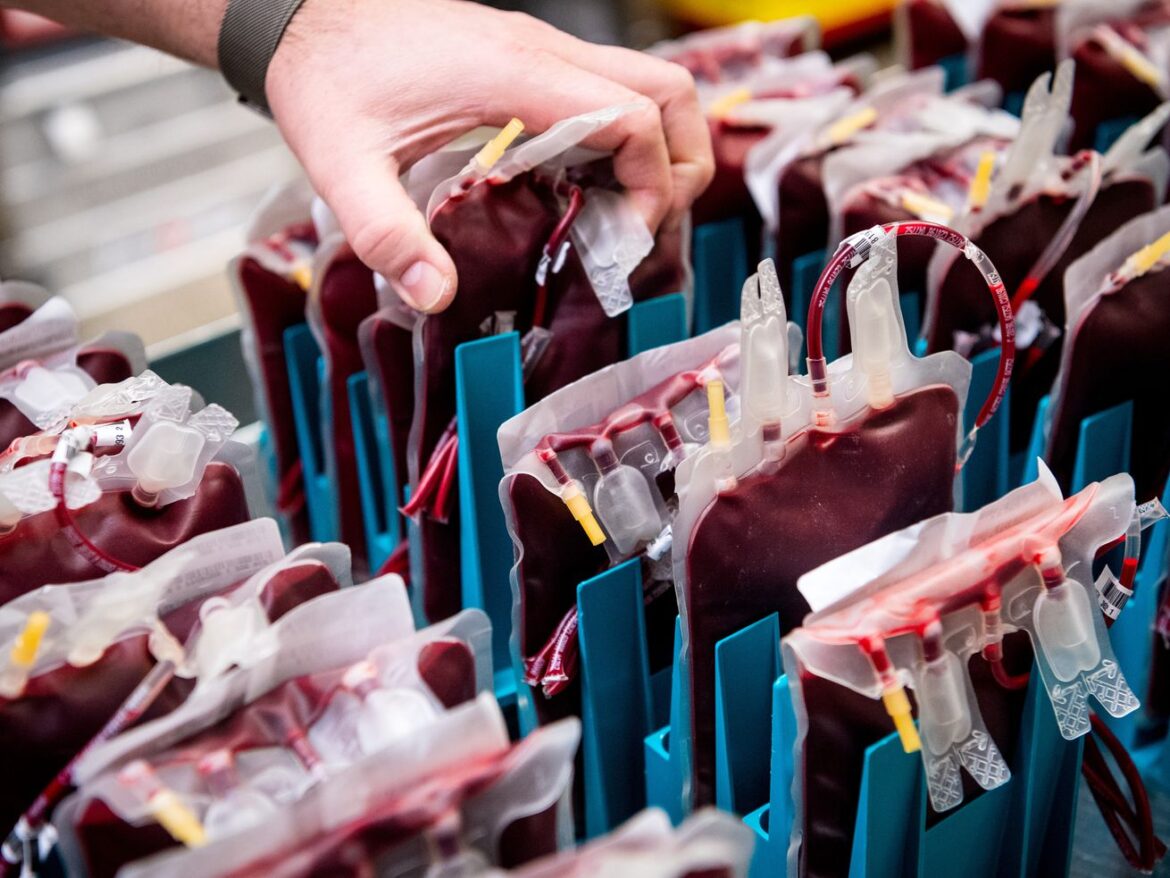The quixotic, centuries-long search for blood alternatives is finally succeeding.
Certain parts of the human body, it turns out, are replaceable.
We’ve engineered artificial hearts that beat, dialysis machines that filter blood, cochlear implants that bypass acoustic hearing, and collagen scaffolds that help generate skin. We’ve synthesized and administered hormones for gender-affirming therapy, period suppression, birth control, cancer, menopause, and diabetes. We’ve designed prosthetics to replace not only limbs and digits but also noses, ears, breasts, and genitals. We’ve swapped out titanium for bones, gold for teeth, glass for eyes.
Across our physiological fabric, however, blood remains an inimitable and fragile thread. This precious, near-magical substance cannot yet be synthesized, manufactured, grown at scale, or stockpiled long term. Today, we have just one way to procure it for transfusion: the goodwill of donors, which often is not nearly enough to meet societal need, resulting in an “uncounted” number of deaths from trauma, postpartum hemorrhage, and childhood anemias.
Blood is essentially its own organ system, said Philip Spinella, surgery and critical care professor at the University of Pittsburgh, co-director of its Trauma and Transfusion Medicine Research Center, and associate medical director of its Center for Military Medicine Research. In humans, it circulates along a 60,000-mile-long vascular freeway, distributing oxygen, cycling nutrients and hormones, removing waste, defending the immune system, distributing heat, and maintaining the body’s chemical and fluid balance as it travels. About one-twelfth of an adult body’s weight is owed to blood’s miracle blend of water, proteins, salts, sugars, fats, oxygen-rich red blood cells, and clot-inducing platelets.
In centuries past, physicians unsuccessfully tried substituting blood with beer, urine, salt water, and milk. But over the last decade, scientists have finally started to make breakthroughs in the medical quest to imitate fresh human blood. Last fall, a groundbreaking UK clinical trial successfully transfused two teaspoons of lab-grown blood into patients, while other approaches are seeking to synthetically recreate blood’s various elements and combine them into a functional substitute for the real thing.
These projects remain in early phases, and experts caution that it will be years — potentially a decade — before artificial blood pumps freely through human veins. But in their grandest visions, researchers believe artificial blood could revolutionize how we supply the vital fluid in medical emergencies and, just maybe, even herald a world without blood shortages.
Around the world, blood is in chronically short supply
Every two seconds, someone in the US needs blood. They might need a transfusion for surgery or post-partum hemorrhaging, for cancer therapies, for traumatic injuries from traffic crashes or gunshot wounds, or to treat diseases including sickle cell, malaria, and thalassemia. The leading cause of preventable death from trauma is hemorrhage — uncontrolled blood loss — which kills between 30,000 and 60,000 Americans each year. For those with rare blood types, access to transfusion is inherently harder; finding an exact blood match for them “can be as difficult as looking for a needle in a haystack,” according to the Red Cross. About one in 18 hospitalized patients receive a blood transplant, and demand for donations will only swell as the general population ages, experts say.
During the pandemic, the blood supply shortage reached crisis levels in the US, as fewer people donated and blood donation centers struggled to survive financially. Last year, the American Red Cross announced it was facing its worst shortage in more than a decade and could only meet one-quarter of hospital demand. Overseas around the same time, the United Kingdom’s blood stock drained to about two days’ worth (they normally aim to stock enough for at least six days).
About 60 percent of the world’s nations — including every country in sub-Saharan Africa, South Asia, and Oceania — already chronically struggles to meet the need for blood. Half of blood collected around the world each year comes from the United States, Canada, Europe, and Australia, which altogether account for just one-fifth of the global population. “The consequences of this scarcity are dire,” a global research group noted in 2021.
Disasters regularly sharpen this scarcity’s deadliness — like this past February’s earthquake that killed 50,000 people and injured 122,500 more in Turkey and Syria, or the 160-plus mass shootings that have claimed 225 lives in the US and injured hundreds more so far in 2023. In times of emergency or not, “there’s a persistent challenge to getting enough,” said Anirban Sen Gupta, a professor of biomedical engineering at Case Western Reserve University in Cleveland and CTO of the biopharma company Haima Therapeutics, which is developing synthetic platelets.
When a hospital’s blood stock runs low, canceling elective surgeries serves as a first defense, Li Chai, a transfusion specialist and pathologist at Brigham and Women’s Hospital and Harvard Medical School, told me. But sometimes even that may not be enough, forcing physicians to make excruciating decisions to, for example, transfuse cancer patients or preserve precious blood stores for extreme medical emergencies. “It’s really hard for me to say, ‘I have nothing for you’” to a patient who needs blood, said Chai.
And so, researchers are striving toward the unprecedented: to outsource the production of blood away from our marrow and into the lab — a project that began in earnest 400-plus years ago.
A brief medical history of blood replacements
With its direct connection to the heart, its vivid hue (from wine-dark to cherry bright and cobalt blue), and its spilling in both birth and death, blood has historically served as a metaphor for humanity, as Susan Lederer, a professor of medical history and bioethics at the University of Wisconsin-Madison, argues in her 2008 book, Flesh and Blood. “Write with blood, and thou wilt find that blood is spirit,” wrote Friedrich Nietzsche in the 1880s. “All the soarings of my mind begin in my blood,” wrote Rainer Maria Rilke in 1921. “Blood is memory without language,” added Joyce Carol Oates, more recently.
“People understood it as part of their vital essence,” Lederer told me. “The kidney has much less romance about it.”
Before medicine learned routinely to save lives by sharing blood between bodies in the early 1900s, Lederer writes, healers first spent centuries trying to heal illnesses and disease by draining blood away with lances and leeches. After physician William Harvey described the circulatory system in 1628, Europeans began to consider the possibility of adding liquids like animal blood to the bloodstream. These early pioneers struggled to prove transfusion’s safety and efficacy when faced with the physiological reality that blood clots when exposed to air, can transmit disease, and can even prove toxic when mismatched (blood groups were not discovered until 1901). By the end of the 17th century, they largely discarded transfusion between humans as a dangerous procedure with little, if any, medical value, Lederer notes.
After a century-plus of dormancy in Europe, North American physicians started up their own transfusion experiments on patients dying of yellow fever and cholera. These efforts were not widespread; during the American Civil War, in which some 750,000 combatants died — and tens of thousands of limbs were amputated on the battlefield — there exist just four records of transfusions, Lederer writes.
The earliest successful transfusions — in the early 20th century — were born of desperation. When no other lifesaving options remained, surgeons infused blood from one patient to another by literally sewing together their exposed blood vessels, which Lederer notes, possessed “the consistency of wet matchsticks.” Over time, advancements such as sterile needles, anticoagulants, and centrifugation made it possible to (almost) painlessly draw blood, refrigerate it for days at a time, and fraction it into its constituent parts: red and white blood cells, plasma, and platelets.
All the while, researchers have continued to look for alternatives to donated fresh blood, which comes with many limitations: It risks disease transmission, can’t be stored long term (no more than 42 days), and there’s never enough of it. They’ve experimented for nearly a century with chemically modifying free hemoglobin isolated from red blood cells, but found that these solutions ultimately caused kidney damage and vascular hypertension. Researchers also tried infusing rodents and humans with perfluorochemicals, polymers they hoped would function as red blood cell substitutes, but discovered the transfusions led to fever, inflammation, and low oxygen.
The quest for artificial blood remained unfulfilled.
From lab-grown blood to the “Impossible Burger of blood”
Contemporary researchers — spurred by advances in nanotechnology, bio-inspired engineering, synthetic chemistry, and stem cell research — have developed two distinct strategies for alternatives to fresh blood. They can be analogized to the differing approaches to slaughter-free meat. On one hand, you have the “meatless but meat-like” camp: products made of peas, mung beans, rice, or soy designed to evoke meat without any animal products, like the Beyond or Impossible Burgers. On the other, you have the “cultivated meat” approach, which cultures and grows animal muscle and fat cells in bioreactors, resulting in a meat that is biologically and chemically identical to its farm-raised counterpart.
The first method — the Impossible Burger of blood — aims to reverse-engineer or repackage whole blood’s various components, primarily to make them easier to store at ambient conditions and, later, deliver in the field. To imitate platelets, for example, one research group has engineered nanoparticles — artificial lipid spheres decorated with special peptides — that can facilitate clotting at the site of bleeding once administered through an IV. Others focused on oxygen-rich red blood cells have coated purified human hemoglobin with an artificial lipid membrane to create a bio-synthetic replica with a corpuscle’s “natural” size, shape, electric charge, and surface chemistry. Still other groups have tried freeze-drying plasma from a cloudy yellow broth into a powder that can be stored at room temperature for two years.
A new $46 million Department of Defense DARPA project, FSHARP, aims to combine several of these approaches to produce a lightweight, portable, shelf-stable powder that would become blood-like when mixed with a sterile saline solution. “It’s basically ‘just add water,’” said University of Pittsburgh surgeon Spinella, a co-investigator in the project who also is a co-founder of KaloCyte, which is developing an artificial red blood cell, and scientific adviser to the biopharma company Haima Therapeutics. The product would overcome the logistics barriers of delivering fresh blood in remote settings: battlefields, cruise ships, space shuttles, depots for mass casualty events, and geographic regions lacking the infrastructure for adequate donor bloody supply and storage. Researchers hope to move these approaches to human trials within five to eight years.
Scientists trying to grow whole blood in sterile settings, a practice called “blood pharming,” took a major step forward last fall when, for the first time, researchers and collaborators in Bristol, Cambridge, London, and NHS Blood and Transplant transfused a few teaspoons of lab-grown blood into two experimental subjects with no reported adverse effects.
To grow the blood, researchers use magnetic beads to extract viable stem cells from standard blood donations. They then cultivate around half a million stem cells in 5 millimeters of a nutrient-rich medium into billions of red blood cells over about three weeks, before filtering and testing the resulting substance for safety. Eventually, the trial will include a total of 10 human subjects, who will each receive, six months apart, transfusions of donated blood and lab-made blood grown from that same human donor’s cells. Researchers will carefully monitor how long each blood type — donated and lab-grown — stays in the body, and what kind of antibodies, if any, they elicit from the immune system.
In the boldest fantasies, both pharmed and artificial sanguine substances could go so far as to not only imitate, but augment, donor blood’s utility.
For example, lab-grown methods could eventually make extra blood from rare-type donations and even genetically modify them to deliver enzymes or therapeutics to people with blood disorders, said Ash Toye, a professor of cell biology at the University of Bristol involved in the lab-grown blood trial. “My vision is a warehouse full of machines making blood,” he said.
Scientists working on the Defense Department project told Vox that powdered blood’s clotting and oxygen-delivery capabilities could be adjusted based on the patient’s unique biology and medical need. “There’s a lot of bespoke custom uses,” said Allan Doctor, the project’s lead investigator, a pediatrics and bioengineering professor at the University of Maryland and director of the school’s Center for Blood Oxygen Transport and Hemostasis, and a co-founder of KaloCyte. Just as oncologists tailor a patient’s chemotherapy to their cancer’s specific genetics, artificial blood specialists could create blends ideal for post-partum hemorrhaging, pre-surgical preparations, or transplant organ perfusion. “That’s the level of precision medicine we need to achieve in transfusion,” said Matthew Neal, a trauma surgeon, director of emergency general surgery at the University of Pittsburgh Medical Center, co-director of its Trauma and Transfusion Medicine Research Center, DARPA investigator, and Haima Therapeutics’ chief medical officer.
But like their predecessors, today’s researchers are struggling to outperform the practicality and performance of natural blood.
Blood pharming, for example, faces efficiency, resource, and time constraints. For one, there’s a limit to how much blood the recruited stem cells can make outside of bone marrow’s niche environment. “The system can only expand so far. There’s a limitation to how much you can grow,” Toye said. “Eventually you exhaust those stem cells.” Expense poses a hurdle too. It costs between $80 and $100 to collect, store, test, and handle donor blood; lab-grown blood, experts say, can run thousands of dollars per unit to produce.
The powdered blood approach, meanwhile, needs to braid together separate scientific efforts to replicate or artificially preserve red blood cells, plasma, and platelets. There’s practically no chance that it all works in symphony right away, Doctor said. “The likelihood that we happened to make it in a way that it will work harmoniously is zero,” he said. “It’s like saying, ‘I made the best key and you made the best lock.’ What are the chances they’re going to fit together?”
It’ll be a while before any artificial blood products are made available to the public, as they have yet to prove their efficacy and safety through rigorous animal and clinical trials. But these projects also open up a plethora of ethical, social, and legal questions, said Shannon E. French, a Case Western ethicist tasked with monitoring and exploring these implications.
Will the final version of an artificial blood contain any animal products that some religions or philosophies don’t condone consuming? Will it help equalize access to blood, or will it remain a revolutionary product that only the richest nations have access to? Could it even, given the Defense Department’s interest in the project, create a moral hazard that encourages the military to send troops further into remote or hostile areas, knowing that blood would be readily available to treat the injured? Even if the science is all there, the way that it shapes society is unforeseeable. “It might not do the good that it’s meant to do,” French said.
For now, synthetic blood researchers have to confront the inescapable fact that their alternative has to be, at a minimum, as good as the real thing. And that’ll be a high bar to clear, Sen Gupta said. “Mimicking nature is not easy.”
Marion Renault is a freelance science, health, and environmental journalist based in Grenoble, France. Their work — which often focuses on extinction, ecology, caregiving, and emergency medicine — has appeared in the Atlantic, the New York Times, the New Republic, STAT, Slate, the New Yorker, Wired, and more.



